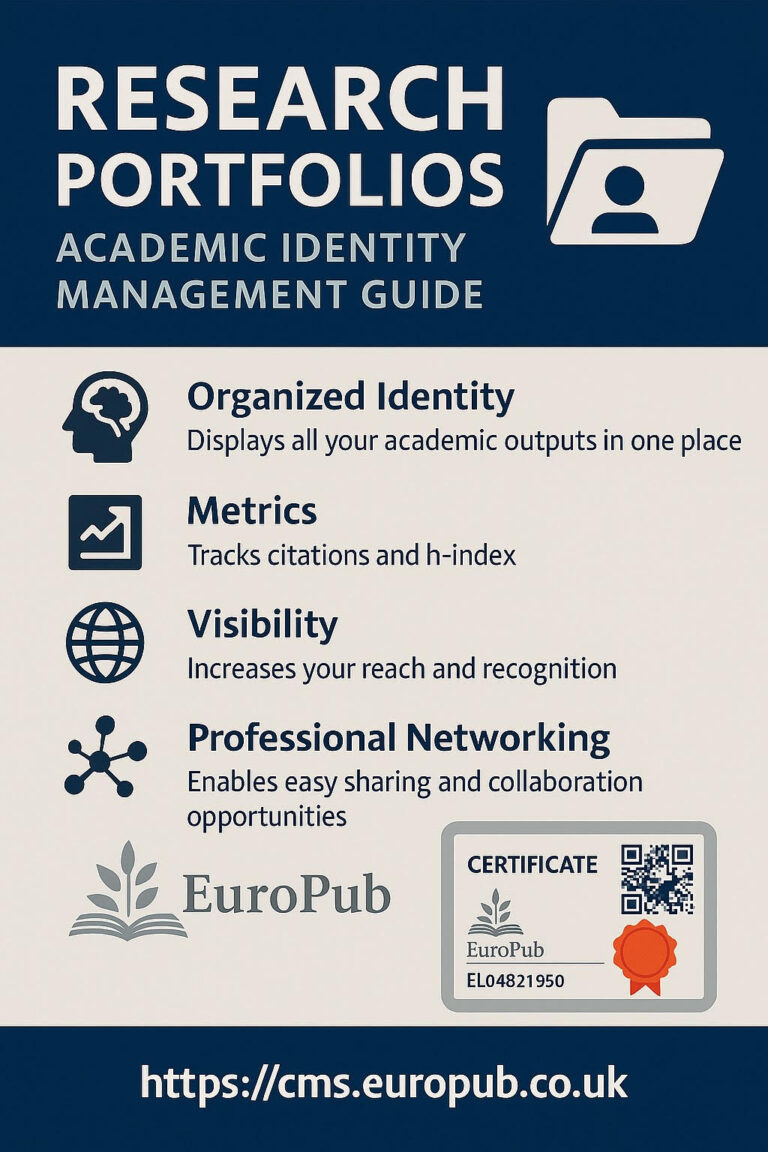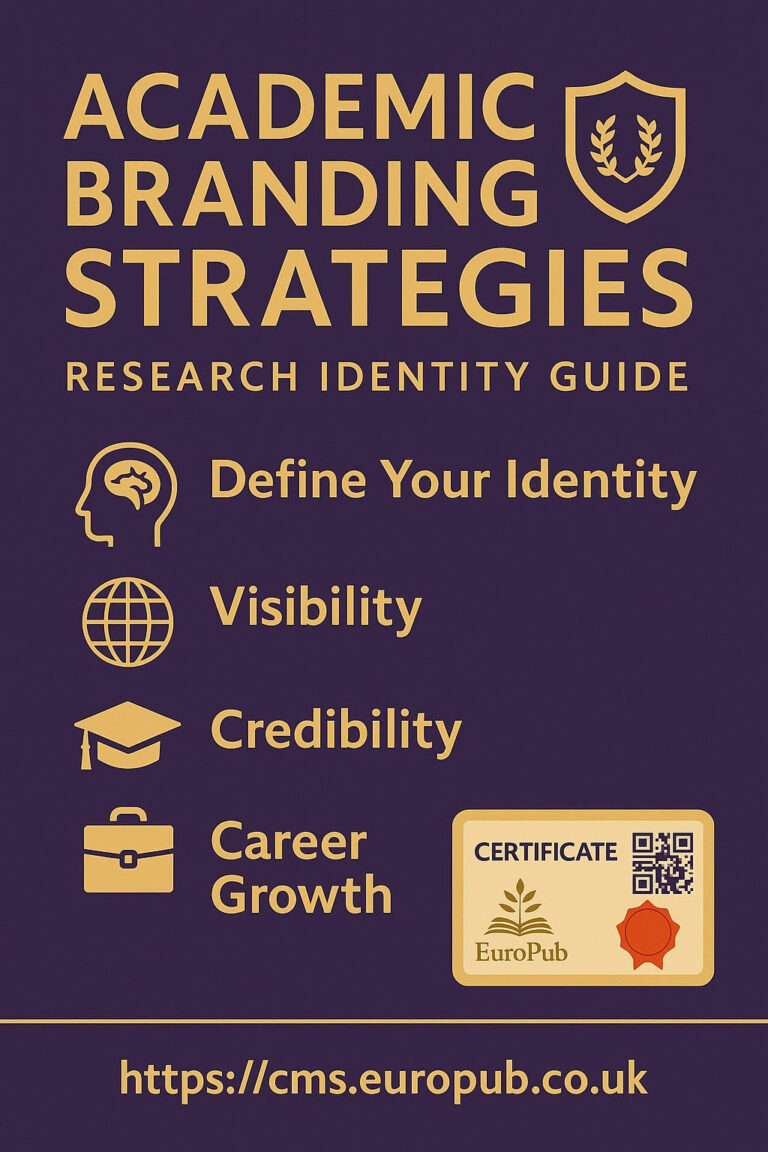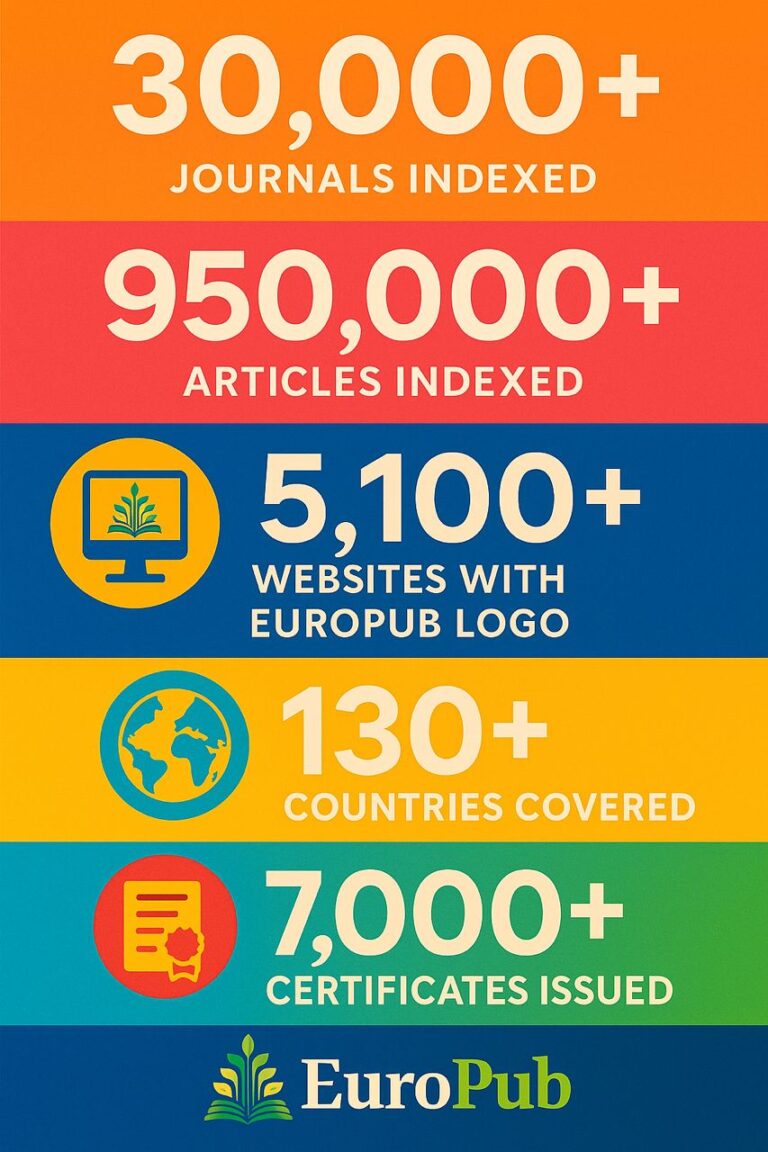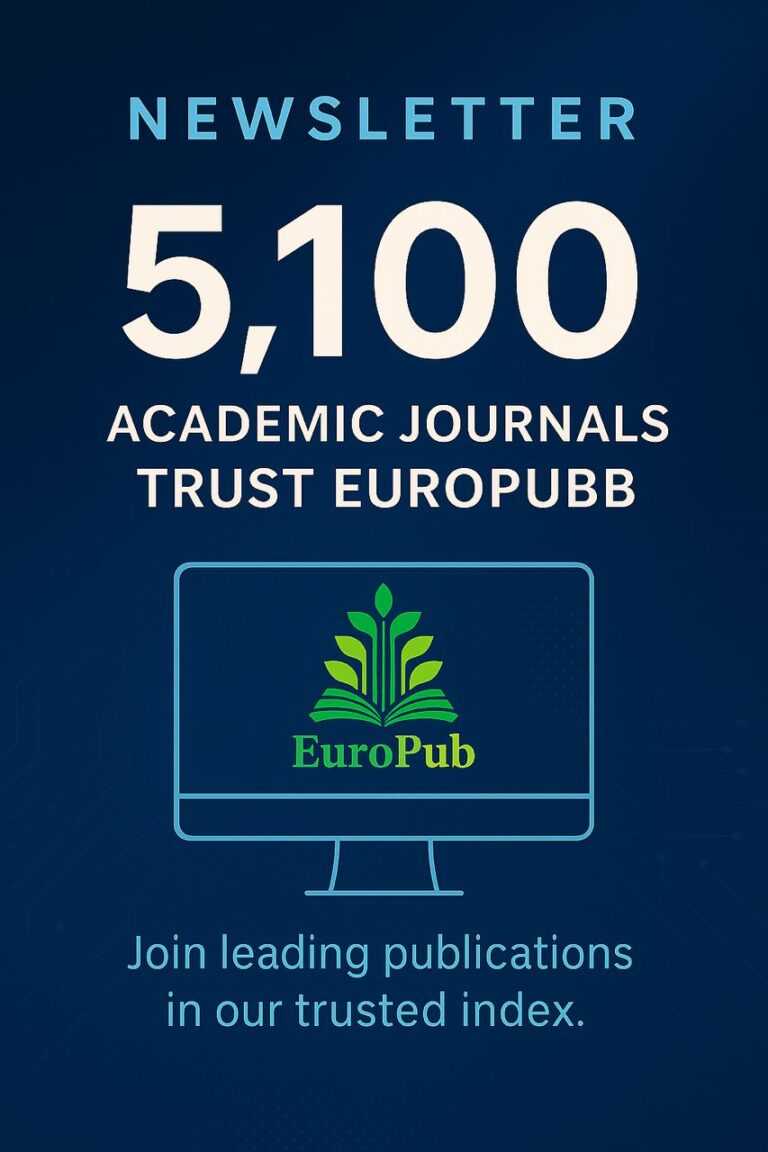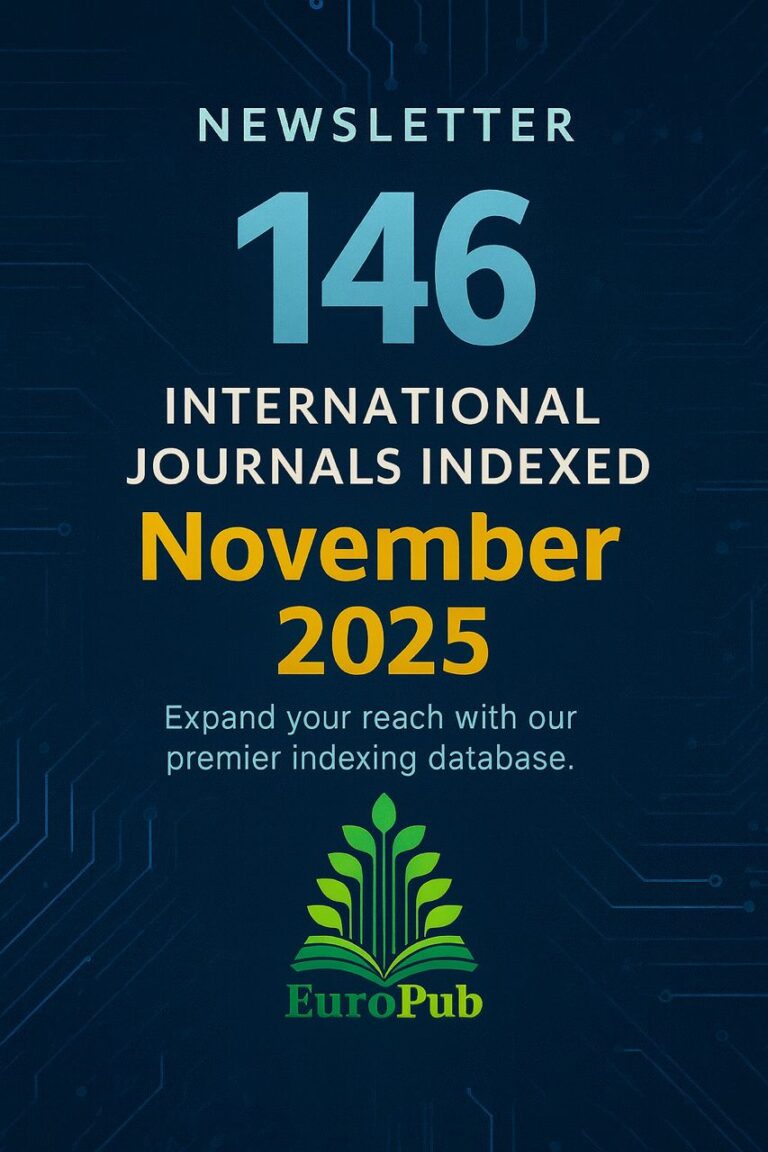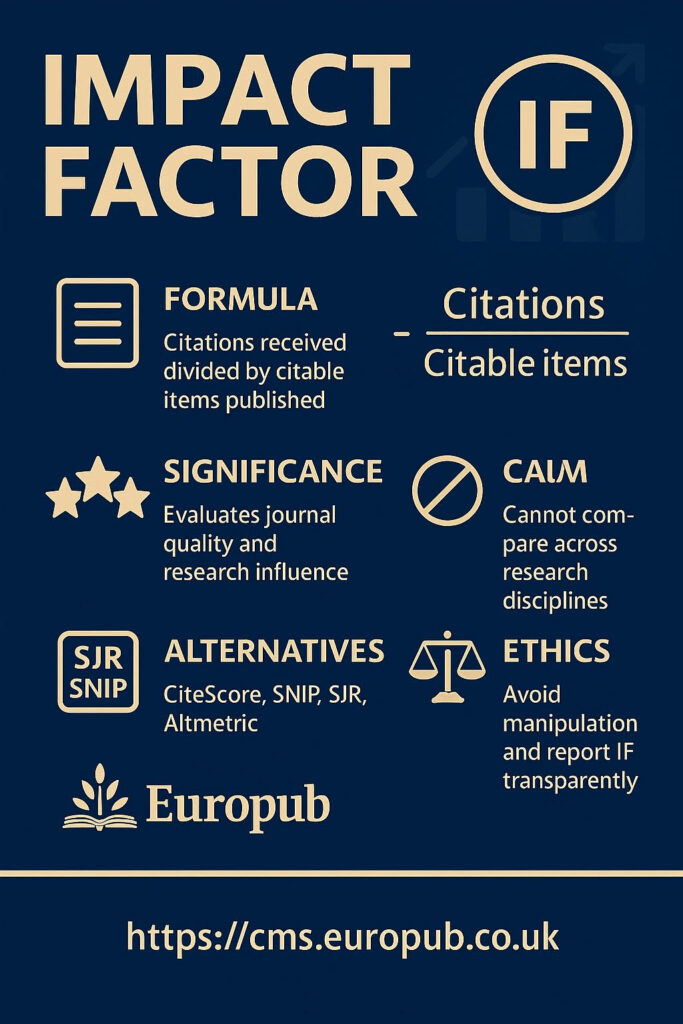
 What Is an Impact Factor?
What Is an Impact Factor?
The Impact Factor (IF) is a scientometric index used to measure the average number of citations received by articles published in a journal during a defined period (usually the previous two years). It was introduced by Eugene Garfield and is published annually by Clarivate Analytics through the Journal Citation Reports (JCR).
The IF serves as a proxy for journal influence, helping researchers, librarians, and institutions assess the visibility, credibility, and research impact of journals.
 Formula
Formula
IF_{year} = \frac{\text{Citations in year N to items published in years N-1 and N-2}}{\text{Number of citable items published in years N-1 and N-2}}
 Example:
Example:
If Journal X published 100 articles in 2022–2023 and received 250 citations in 2024 to those articles:
→ Impact Factor (2024) = 250 ÷ 100 = 2.5
 Components of IF
Components of IF
| Component | Description |
|---|---|
| Citable Items | Research articles, reviews, proceedings, short communications. |
| Non-Citable Items | Editorials, letters, news items, corrections. |
| Citation Window | Typically two years (e.g., 2024 IF counts citations from 2024 to 2022–2023 articles). |
| Source Database | Web of Science (Clarivate Analytics). |
 Significance of Impact Factor
Significance of Impact Factor
- Evaluates journal quality and prestige.
- Guides author submission decisions.
- Influences institutional rankings.
- Used by funding agencies and universities for promotion and evaluation.
- Helps journals benchmark their performance over time.
 Limitations of IF
Limitations of IF
 Focuses on journal, not individual article quality.
Focuses on journal, not individual article quality.
 Citation distribution is skewed (few papers get most citations).
Citation distribution is skewed (few papers get most citations).
 Not suitable for non-indexed or emerging journals.
Not suitable for non-indexed or emerging journals.
 Vulnerable to citation manipulation and self-citation bias.
Vulnerable to citation manipulation and self-citation bias.
 Doesn’t capture alternative impact (e.g., downloads, media, or policy influence).
Doesn’t capture alternative impact (e.g., downloads, media, or policy influence).
 Alternative Metrics
Alternative Metrics
| Metric | Description |
|---|---|
| CiteScore (Scopus) | Average citations per document over 4 years. |
| SNIP | Source Normalized Impact per Paper. |
| SJR | SCImago Journal Rank — measures prestige & citation network strength. |
| Altmetric | Social, media, and policy attention score. |
| Europub Impact Rating (EIR) | Europub’s journal-level rating that combines originality, peer-review quality, and editorial consistency. |
 Understanding Journal Quartiles (Q1–Q4)
Understanding Journal Quartiles (Q1–Q4)
Journals in JCR are divided into quartiles:
- Q1: Top 25% — Excellent
- Q2: 26–50% — Strong
- Q3: 51–75% — Moderate
- Q4: 76–100% — Developing
 Ethical Use of Impact Factors
Ethical Use of Impact Factors
- Never compare across disciplines (IF is field-dependent).
- Avoid coerced citations or citation stacking.
- Report IF transparently, with citation year and source.
- Follow COPE and WAME guidelines for ethical citation behavior.
 FAQs (Frequently Asked Questions)
FAQs (Frequently Asked Questions)
Q1. Who calculates Impact Factor?
 Clarivate Analytics (formerly Thomson Reuters) via the Web of Science database.
Clarivate Analytics (formerly Thomson Reuters) via the Web of Science database.
Q2. What is a “fake” Impact Factor?
 Non-Clarivate metrics (e.g., “Global IF,” “Universal IF”) with no data transparency. Always verify in JCR.
Non-Clarivate metrics (e.g., “Global IF,” “Universal IF”) with no data transparency. Always verify in JCR.
Q3. How often is IF updated?
 Annually, in June through the Journal Citation Reports.
Annually, in June through the Journal Citation Reports.
Q4. What is the difference between IF and CiteScore?
 CiteScore is based on Scopus data and uses a 4-year window; IF uses 2 years and Web of Science.
CiteScore is based on Scopus data and uses a 4-year window; IF uses 2 years and Web of Science.
Q5. Can conference proceedings have an Impact Factor?
 No. Only journals indexed in Web of Science Core Collection qualify.
No. Only journals indexed in Web of Science Core Collection qualify.
Q6. What is a “rolling” or “estimated” IF?
 Unofficial yearly calculations (e.g., internal publisher estimates) for guidance — not recognized by Clarivate.
Unofficial yearly calculations (e.g., internal publisher estimates) for guidance — not recognized by Clarivate.
Q7. How can a journal improve its IF?
 Publish high-quality, novel research.
Publish high-quality, novel research.
 Reduce review and publication lag.
Reduce review and publication lag.
 Promote published works for visibility.
Promote published works for visibility.
 Maintain ethical citation practices.
Maintain ethical citation practices.
Q8. Can Impact Factor be zero?
 Yes, if no citations occur within the citation window.
Yes, if no citations occur within the citation window.
Q9. Are all journals with IF open access?
 No. Both open access and subscription journals can have Impact Factors.
No. Both open access and subscription journals can have Impact Factors.
Q10. What happens if a journal manipulates IF?
 Clarivate may suspend its IF or delist the journal.
Clarivate may suspend its IF or delist the journal.
Q11. Can authors check IF before submission?
 Yes — search the journal on Journal Citation Reports or Master Journal List.
Yes — search the journal on Journal Citation Reports or Master Journal List.
Q12. Does Europub assign Impact Factors?
 Europub provides an independent Impact Evaluation 2024 metric for journals indexed in its database (https://cms.europub.co.uk).
Europub provides an independent Impact Evaluation 2024 metric for journals indexed in its database (https://cms.europub.co.uk).
Q13. What is the acceptable self-citation limit?
 Typically below 15% of total citations.
Typically below 15% of total citations.
Q14. Can new journals get IF immediately?
 No. They must be indexed for at least 2 years in Web of Science before evaluation.
No. They must be indexed for at least 2 years in Web of Science before evaluation.
Q15. Are Impact Factors comparable across fields?
 No — IF varies widely across disciplines (e.g., Medicine vs. Mathematics).
No — IF varies widely across disciplines (e.g., Medicine vs. Mathematics).
 Useful Links
Useful Links
- Journal Citation Reports – Clarivate
- Master Journal List
- SCImago Journal Rank (SJR)
- Europub Impact Factor 2024
- COPE Citation Ethics
 Summary
Summary
| Element | Description |
|---|---|
| Purpose | Measures average citation impact of journals. |
| Calculated by | Clarivate Analytics (JCR). |
| Window | Two years. |
| Ethics | Avoid manipulation; transparency required. |
| Alternatives | CiteScore, SNIP, SJR, Europub Impact Rating. |
